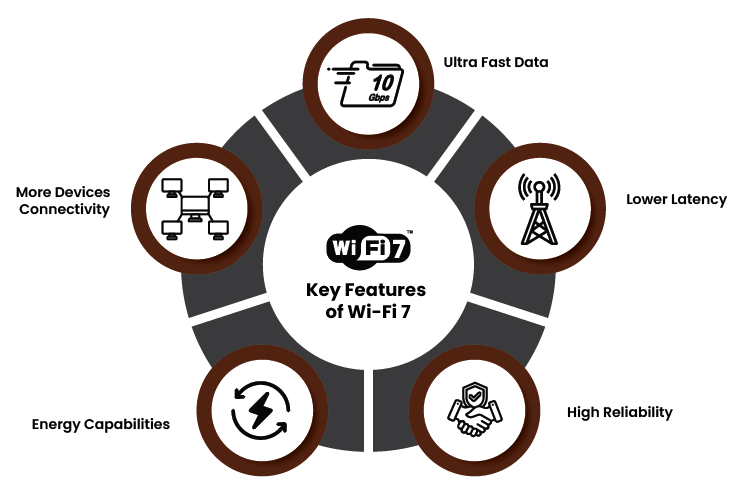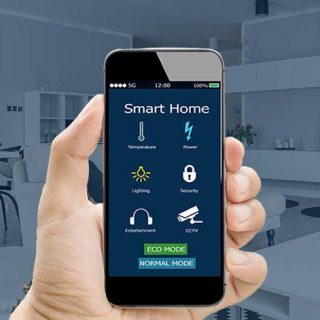In an increasingly digital world, a robust and lightning-fast internet connection has become more essential than ever. Just as we settle into the benefits of Wi-Fi 6 and 6E with its impressive speed and reliability, the next generation of wireless technology is already on the horizon. Wi-Fi 7, set to revolutionize our digital experiences, promises to deliver even faster speeds, lower latency, and the ability to seamlessly accommodate an ever-expanding ecosystem of connected devices. In this blog, we’ll explore the exciting features of Wi-Fi 7, with Wi-Fi 6 and 6E.
Introduction to Wi-Fi 7
The 7th generation of Wi-Fi, known as Wi-Fi 7 or IEEE 802.11be, represents a major progression compared to Wi-Fi 6 and 6E. It is expected to deliver speeds up to four times faster while introducing innovative features to reduce latency, enhance capacity, and improve overall stability and efficiency.
Specifications of Wi-Fi 7
Wi-Fi 7 supports a large number of devices with diverse requirements, from smartphones and laptops to IoT sensors and emerging technologies, while providing a seamless and high-quality wireless experience. Here are some advanced specifications:
- Multi-link Operation : In Wi-Fi standard this has been a completely new feature. The existing wireless infrastructure, access points typically accommodate three channels, consisting of a lower band at 2.4GHz and two higher bands at 5GHz and 6GHz. However, Wi-Fi 7 technology is set to make the potential of multichannel utilization with remarkable efficiency, thereby boosting data rates significantly. This innovative approach allows dynamic channel switching to achieve maximum throughput depending on the availability.

Take, for instance, a device’s capability to use high-frequency support in either one 5GHz band or simultaneously in both a 5GHz and a 6GHz band. This approach results in a substantial boost in data speed and overall efficiency. The use of multiple links stands out as a powerful strategy for enhancing efficiency, particularly in crowded settings such as sports venues, airport terminals and hospitals.
- Multiple 6 GHz Spectrum : Bandwidth currently provides access to multiple 160MHz spectrum channels, primarily in the 6GHz band (where supported by regional regulations). However, Wi-Fi 7 has double data transfer capabilities, offering an impressive 320MHz channel bandwidth which is faster than 6th generation. The multi-link feature empowers the establishment of a 320MHz effective channel by combining two 160MHz channels within a high-frequency band. This advancement enables higher data throughputs, making it possible to achieve improved performance, even in regions where the 6GHz spectrum has not been allocated.
- Multiple Access Point : In a network with multiple access points, devices typically select and connect to one specific access point while neglecting others. Once a device establishes a connection with a particular access point, it signals nearby access points to lower their transmission power (especially if the device is closer to one of them), reducing interference. Additionally, the concept of joint transmission comes into play, where multiple access points collaborate to transmit data simultaneously, enhancing signal strength and network performance.
- Smart Interference Avoidance : In a conventional Wi-Fi setup, when a user utilizes a segment of the spectrum, it results in that spectrum becoming inaccessible for others, causing interference. However, in Wi-Fi 7, a technique known as “Preamble Puncturing” is applied to avoid this issue. This method essentially steers clear of the occupied spectrum portion and enables the allocation of uninterrupted channels within the same spectrum, effectively preventing interference.

- Automated Frequency Coordination : The 6GHz band, which has a wide range of frequencies available (from 5.925 to 7.125 GHz), is becoming popular for both licensed and unlicensed wireless communication. It’s great for applications that need a lot of data and fast responses, like self-driving cars and streaming videos on demand. AFC uses data about where signals are coming from. It collects this information and creates a database in the cloud. Then, it does calculations to make sure Wi-Fi in the 6GHz band won’t cause problems by interfering with other devices.
- Higher QAM : The higher the QAM level, the more data can be transmitted. Wi-Fi 7 supports 4K-QAM while Wi-Fi 6 and Wi-Fi 5 are restricted to 1024-QAM and 256-QAM respectively. However, the potential advantages of higher QAM levels are signal strength, background noise, and interference. As the QAM level increases, the range decreases, and a stronger signal is required for reliable communication. In the transition to 4K-QAM in Wi-Fi 7, there is a 20 percent increase in peak performance.
Key Features of Wi-Fi 7
- Ultra Fast Data : Wi-Fi 7 is set to offer incredibly fast data speeds, reaching up to 46.1 Gbps, making it the fastest wireless option available. It achieves this remarkable speed by using advanced technologies such as multi-link connections, MIMO, higher order modulation schemes and access to a broader range of frequencies. Wi-Fi 7 provides super-fast internet for things like augmented reality, virtual reality, and high-quality gaming, making sure users have a great experience.
- Lower Latency : The previous version of wi-fi, one access point was used, which could lead to delays in data transmission. But in Wi-Fi 7, it’s possible to have access to multiple connections at the same time, which greatly reduces the time it takes to send and receive data. While Wi-Fi 6 already managed to get latency down to just a few milliseconds, Wi-Fi 7 takes it even further. With its support for multi-link operations, it can bring latency down to less than five milliseconds.

- High Reliability : By duplicating data packets across multiple links, Wi-Fi 7 significantly lowers the risk of losing information, which results in a highly dependable and reliable connection.
- Energy Capabilities : With Wi-Fi 7 architecture, the effective use of spectrum and overall network is possible. In highly crowded environments, such as airports, sports complexes, access points can efficiently manage numerous devices using advanced algorithms and techniques like MIMO and beamforming. Network energy efficiency is a vital feature. It intelligently calculates the transmission power needed for each device within its range, minimizing interference, and enhancing the overall energy efficiency of the system.
- More Devices Connectivity : Wi-Fi 7 has the capacity to manage more devices per access point than previous generations like Wi-Fi 6 and 6E. Even as the number of connected devices increases, important resources such as speed and latency remain unaffected.
Wi-Fi 7 vs. Wi-Fi 6/6E
| Wi-Fi Generations | |||
| Wi-Fi 6 | Wi-Fi 6E | Wi-Fi 7 | |
| IEEE Standard | 802.11ax | 802.11be | |
| Max data rate | 9.6 Gbps | 46 Gbps | |
| Frequency bands | 2.4 GHz and 5 GHz | 6 GHz | 1-7.25 GHz (including 2.4 GHz, 5 GHz, 6 GHz bands) |
| Security | WPA 3 | WPA 3 | |
| Channel bandwidth | 20, 40, 60, 80+80, 160 MHz | Up to 320 MHz | |
| Modulation | 1024 - QAM OFDMA | 4096 - QAM OFDMA (with extensions) | |
| MIMO | 8х8 UL/DL MU-MIMO | 16х16 MU-MIMO | |
Source: IEEE, Intel Corporation, Wi-Fi Alliance
Diverse Applications of Wi-Fi 7
Home Automation Solution
Wi Fi 7 brings us closer to an intelligent lifestyle. When you have various inter-connected devices at home, Wi-Fi 7 ensures they stay connected with lightning-fast response times. With smarter and more powerful networks of wi-fi 7, homeowners could control all their smart devices, from thermostats to security cameras, with minimal delays.
Interactive Telemedicine
Implementing interactive telemedicine with Wi-Fi 7 revolutionizes remote healthcare experiences. It enables virtual visits with healthcare professionals, sharing vital signs through connected devices and receiving immediate responses. Wi-Fi 7 ensures a reliable and responsive connection, fostering a more interactive and personalized telemedicine experience that bridges the distance between healthcare providers and patients.
Wi-Fi 7 empowers manufacturers to monitor machinery, track inventory and ensure product quality with unparalleled precision. IIoT networks equipped with Wi-Fi 7 enable predictive maintenance, reducing downtime and minimizing costly production interruptions. Moreover, the enhanced security features of Wi-Fi 7 are paramount in protecting confidential industrial data, making it a key enabler for the fourth industrial revolution and the factory of the future.
Real-time Collaboration
Wi-Fi 7 brings real-time collaboration to new heights by delivering exceptional speed and low latency. Whether in business meetings, virtual classrooms, or collaborative projects, Wi-Fi 7 ensures data transfer and communication without delay. This advanced technology enables seamless video conferencing, instant document sharing, and simultaneous editing in real-time.
About VOLANSYS
VOLANSYS has a track record of expertise in connected technology and comprehensive service offerings, aiding clients in the development of cutting-edge solutions. Serving as a one-stop solution provider, we excel across all phases, starting from ideation, design, development and testing, to meet the evolving demands of our clients consistently. Explore our success stories for deeper insights into our experience and expertise. For more information, feel free to contact us.

About the Author: Krupa Jagani
As a Marketing Executive at VOLANSYS, an ACL Digital Company, Krupa combines her passion for research with competence for crafting convincing content. Her valuable expertise lies in content creation and developing impactful marketing materials.









